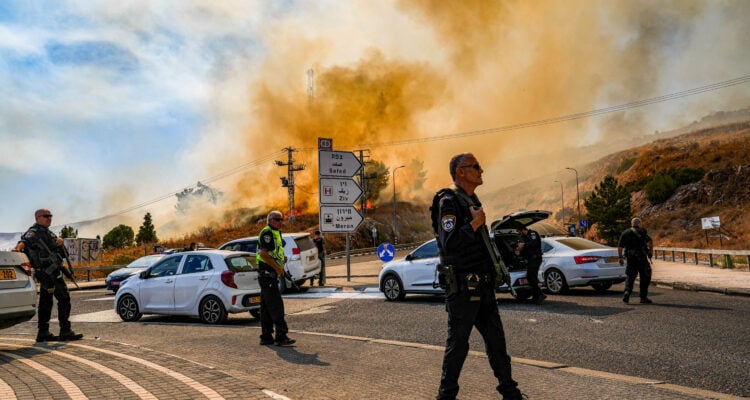Police reported closures along Route 90 from north to south from the Rosh Pina Junction to the Amiad Junction following the launches.
By JNS
Lebanese terrorist group Hezbollah launched approximately 100 rockets at northern Israel on Sunday, in two barrages.
The first was a salvo of 70 rockets targeting northern Israel’s Western and Upper Galilee regions late Sunday morning, the Israel Defense Forces said.
Some of the projectiles were intercepted, while several impacts were detected, according to the IDF.
Israel Fire and Rescue Services were operating to extinguish multiple fires sparked by the attack. There were no immediate reports of injuries or material damage.
Just a few hours later, the Iranian terror proxy launched some 30 rockets at Safed and surrounding areas of the Upper Galilee. Sirens also sounded in Katzrin in the southern Golan Heights.
Residents of Safed reported multiple interceptions in the skies over the city. No injuries or direct hits were reported, but several fires were reported.
Police reported closures along Route 90 from north to south from the Rosh Pina Junction to the Amiad Junction following the launches. One rocket exploded on the road near the Elifelet interchange.
Red Alerts in Safed pic.twitter.com/U3Z23i111g
— Netanel Worthy – נתנאל וורתי (@NetanelWorthy) October 20, 2024
Earlier on Sunday, the Israeli Air Force intercepted a “suspicious aerial target” off the coast of Haifa. Per IDF protocol, no sirens were sounded because the threat, apparently a drone, did not make landfall.
The incident came a day after a Hezbollah drone attack on the Caesarea residents of Israeli Prime Minister Benjamin Netanyahu.
Shortly afterward on Sunday morning, sirens sound in the northwestern port city and the surrounding area, as well as in the Upper Galilee.
Residents reported hearing one interception; Magen David Adom emergency services said they had received no calls about impacts or casualties.
The military later confirmed that it shot down one rocket and that two projectiles fell in an open area in a second wave at northern Israel.
Sirens had sounded in Merom Golan in the northern Golan Heights at around 4:20 a.m. on Sunday due to a drone that had crossed into Israeli airspace from Syria. The threat was intercepted by the Israeli Air Force.
Another drone had triggered sirens in several communities in the southern Golan several hours earlier. That drone too was intercepted, as was another UAV approaching from the east that according to the IDF did not enter Israeli airspace.
A drone was also intercepted on Saturday night near Eilat in southern Israel.
No injuries were reported in either the Golan and Eilat drone attacks, which were claimed by the Islamic Resistance of Iraq, a group of Iranian-backed militias.
The terrorist group has conducted many drone attacks against Israel over the past year in support of Hamas in Gaza.
Alarms were also heard elsewhere in northern Israel overnight, including in the Upper Galilee area, where five projectiles were identified crossing from Lebanon around midnight, according to the IDF, which said that some were intercepted while others fell in open areas.
On Saturday morning, a Hezbollah drone impacted near Israeli Prime Minister Benjamin Netanyahu’s residence in Caesarea. The drone was one of three launched by Hezbollah, two of which were intercepted.
The Lebanese terrorist group launched some 200 projectiles at Israel throughout Saturday.
One of the rockets killed a man near Acre, who was later identified as Alexei Popov, 51, from the Haifa suburb of Kiryat Haim.
Baruch Dayan HaEmet
This was 50 year old Alexei Popov from Haifa who was murdered today while he was in a car in Acco after a rocket exploded next to him
May his memory be for a blessing https://t.co/qSpBlwAGVT pic.twitter.com/0tacBPFN4z
— Documenting Israel (@DocumentIsrael) October 19, 2024
Soldier KIA in Southern Lebanon
The IDF reported on Saturday night that Sgt. Maj. (res.) Yishai (Netanel) Greenbaum had succumbed to wounds sustained during combat operations in Southern Lebanon on Oct. 9.
The 38-year-old from Lod served as a platoon sergeant in the 288 Brigade’s 5030th Battalion.
Baruch Dayan HaEmet
This was 38 year old Sergeant Major (Res.) Yishai (Netanel) Greenbaum, a Platoon Sergeant in Nahal's 5030th Battalion of the 228th "Alon" Brigade, from Lod who died of his injuries sustained while serving in Lebanon
May his memory be for a blessing pic.twitter.com/wryeQ9VbyK
— Documenting Israel (@DocumentIsrael) October 20, 2024
Two more soldiers were killed in battle in the northern Gaza Strip, the IDF said on Saturday night—Staff Sgt. Ofir Berkovich, 20, from Modi’in Maccabim Reut, and Sgt. Elishai Young, 19, from Dimona, both of the 401st Brigade’s 52nd Armored Battalion.
Their deaths bring the total military death toll during the war on all fronts to 748.
Over 65 Hezbollah terrorists killed
The IDF said on Sunday morning that the IAF had killed over 65 Hezbollah terrorists in Southern Lebanon as ground operations continued there.
In addition, the IAF struck dozens of Hezbollah targets, including terrorist cells and launchers directed at Israeli civilians, as well as terror infrastructure sites.
התמרון הקרקעי בדרום לבנון נמשך. כוחות צה"ל מאוגדות 146, 91, 36 ו-98 פועלים להשמדת תשתיות טרור של ארגון הטרור חיזבאללה, מחסלים מחבלים ומחרימים אמצעי לחימה שאותרו>> pic.twitter.com/j67i7yrB8M
— צבא ההגנה לישראל (@idfonline) October 20, 2024
IAF strikes Hezbollah targets in Beirut area
The IAF on Saturday evening struck several Hezbollah weapons storage facilities and a Hezbollah intelligence headquarters command center in the terror group’s stronghold of Dahiya in the southern suburbs of Beirut.
Israel’s military emphasized that many steps were taken before the attack to minimize harm to civilians, including issuing advance warning.
מטוסי קרב של חיל האוויר תקפו לפני זמן קצר, בהכוונה מודיעינית מדויקת של אגף המודיעין, מספר מחסני אמצעי לחימה ומפקדה של מטה המודיעין של ארגון הטרור חיזבאללה בדאחייה שבביירות>> pic.twitter.com/RSwesXrVli
— צבא ההגנה לישראל (@idfonline) October 19, 2024
“This strike joins the efforts to damage Hezbollah’s weapons storage and manufacturing facilities that are embedded beneath residential buildings in the heart of the city of Beirut, endangering the population in the area,” the IDF said.
Hezbollah compound in school
Furthermore, the IDF reported on Saturday that 7th Brigade troops in Southern Lebanon destroyed over 120 Hezbollah targets, several tunnel shafts and more than 20 weapons stockpiles.
Operational Update from IDF activity in Southern Lebanon:
– A Hezbollah 'Radwan Force' command center, which included an area for weapons storage, supplies for extended stays, motorbikes, living quarters, ammunition, and more was destroyed.
– 4 underground Hezbollah… pic.twitter.com/lo2zkiIrEo
— Israel Defense Forces (@IDF) October 19, 2024
Soldiers from the 7th Brigade destroyed a Hezbollah compound embedded in a school in the middle of a Lebanese village. The compound included tunnel shafts and a weapons stockpile.
Additional weapons storage facilities were also destroyed.
Radwan tunnel route destroyed
Soldiers from the 8th Brigade and Yahalom Unit, under the command of the 91st Division, located and destroyed over 50 tunnel shafts and other terrorist infrastructure under mosques, schools and other civilian buildings in Southern Lebanon, the IDF said on Saturday.
Engineering troops destroyed all of the tunnel routes with over 100 tons of explosive material, including an underground Hezbollah Radwan forces command center, which included an area for weapons storage, supplies for extended stays, motorbikes, living quarters and ammunition.
באמצעות למעלה מ-100 טון חומר נפץ: כוחות חטיבת ‘הזקן’ (8) ויחידת יהל״ם השמידו תוואי תת-קרקע מרכזי של יחידת 'כוח רדואן' אשר נחשף בתחילת השבוע
לכל הפרטים והתיעודים>>https://t.co/hrYIuazaWu pic.twitter.com/cOImdJxapR— צבא ההגנה לישראל (@idfonline) October 19, 2024
Dozens of weapons were found near the underground site, including land mines, anti-tank missiles, anti-aircraft missiles, grenades, RPG launchers, machine guns, AK-47 rifles, ammunition and equipment for communication, targeting and observation.





